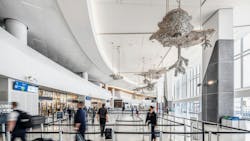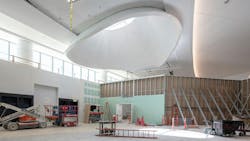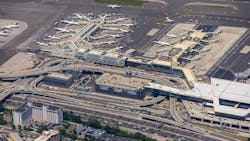How to keep airports functional during construction
By now, we’ve all heard of the unexpected opportunities that came with the COVID-19 pandemic. The first two years of that calamitous event impacted the aviation industry more than most, and things definitely didn’t feel productive while the industry remained shuttered. But it also provided a silver lining: A once-in-a-generation chance to complete major construction projects on accelerated schedules. For a brief but productive window, airport construction turned into a completely different game.
It's no small feat to remain operational while transforming an entire terminal, let alone two. Yet that was precisely the challenge before Delta Air Lines at Los Angeles International Airport (LAX) as they embarked upon redeveloping Terminals 2 and 3. Back in 2017, our team helped orchestrate an overnight terminal shuffle that could easily be considered one of the most challenging terminal moves in commercial aviation history. It ultimately impacted 27 airlines and 10 vendors across four terminals—and cleared the way for Delta to rebuild and connect the two terminals it would call home moving forward.
The pandemic fell smack dab in the construction process. But fortuitously, the reduction in flight activity enabled us to consolidate operations into one terminal while rebuilding the other, an approach that ultimately made the process go blazingly fast without sacrificing needed gates and capacity. In our industry, to say that level of flexibility was unusual would be an understatement.
Staying Functional During Airport Construction
Today, as airports have surged back to full capacity, the industry is reencountering familiar constraints. But having seen how well things can go under ideal construction circumstances, we have fresh optimism and new ideas to share about how to make the process better moving forward. It starts, of course, with what travelers experience as they pass through an airport with ongoing construction.
For travelers, construction shouldn't take a seamless experience off the table.
How do you make airport improvements without disrupting passenger flow? “Pay no attention to the man behind the curtain” is the operative phrase. It sounds simple, but the temporary wall strategy can make a remarkable difference from the traveler’s point of view.
In designing San Francisco International Airport’s (SFO) redeveloped Terminal 1, we cordoned off half of the terminal while keeping the other half operational, with travelers none the wiser. Adorned with elevated finishes and beautiful graphics, the temporary wall met the high aesthetic standards needed for a destination airport like SFO. While we hammered away behind the scenes, the airport maintained the minimum gate count it needed to remain operational. Then when the time came, it was curtain-up and SFO’s new show began.
A related strategy was necessary as we served as lead architect for Delta Concourses D, E, & F at LaGuardia Airport's Terminal C—albeit with a slightly different flavor owing to its New York City context. In the Big Apple, travelers are used to the urban jungle’s sidewalk sheds, and may have a certain patience with the presence of construction as long as things remain operational and what’s on the way is communicated. The LaGuardia project still used temporary walls, but ultimately relied more on strategic tunnels and bridges. These crucial linkages kept people moving to their destinations on time regardless of the work going on around them.
Getting creative with airport construction schedules can be another effective approach, especially for smaller airport projects. To implement our redesign of Tampa International Airport’s baggage claim, construction was carefully planned to maintain a pleasant customer experiences at all stages of implementation. Within the context of a design-build project delivery, all construction on the project is planned to take place overnight, from midnight to 5AM. This will keep the entire baggage claim in operation during the construction period.
The project’s goal is to better the arrival experience and impart a positive lasting impression while bringing cohesion to the airport. Years ago, we may not have considered the construction process as such an integral part of achieving that goal. But Tampa shows us a better way.
Don’t forget about airport employees. Construction shouldn’t disrupt their workflow.
For classification purposes, the World Bank sets the minimum population for a city at 50,000 people. That’s approximately how many people work at LAX and at Atlanta Hartsfield International Airport, the number reaches 63,000. It is no exaggeration, then, to say that an airport workforce is a city unto itself.
Whereas a traveler may interact with an airport under construction once or twice, it’s an everyday experience for the airport employee. Working at an airport already comes with numerous challenges and hurdles, including requirements to pass through additional security precautions and, in most cases, being located away from urban centers.
Construction shouldn't contribute another layer of difficulty. Signage, messaging, temporary walls, and linkages are all important and impactful for back of house settings, too. With employee retention a higher priority than ever for airports and airlines, there can be real value in minimizing everyday inconveniences for employees.
For an accelerated construction schedule, you need collaboration among delivery partners.
Today, airports are as slammed as they’ve ever been. If we want to move quickly as we improve them, that means breaking projects into smaller builds—think of playing hopscotch around the terminal to complete construction one piece at a time. To make accelerated delivery happen, we need to commit to partnering with all project stakeholders in the most balanced way possible.
While renovating a JetBlue ticketing lobby at JFK, our team faced an extremely ambitious schedule of six months from design sketches to a Memorial Day opening. To tackle it, the owner, design team, and contractor all came to the table on day one to break the project up into three construction packages. It was a process of collaborative co-creation—not only in the process of design, but also in delivery. It placed equal value on customers and operations and achieved a remarkable balance given the time constraints. In the end, the project radically transformed the lobby, reducing the passengers’ time from curb to security via the first self-service bag tag and drop system at JFK.
Airport project delivery teams are becoming far more intertwined and integrated than ever before, and this can either complicate or simplify things depending on how the processes and relationships are managed. As aviation architects, we hold a dual responsibility to the intent of our designs and to our partners helping to carry them out. As projects become ever more complex, ambitious, and hastened, the most effective teams will find a healthy balance between those responsibilities.



